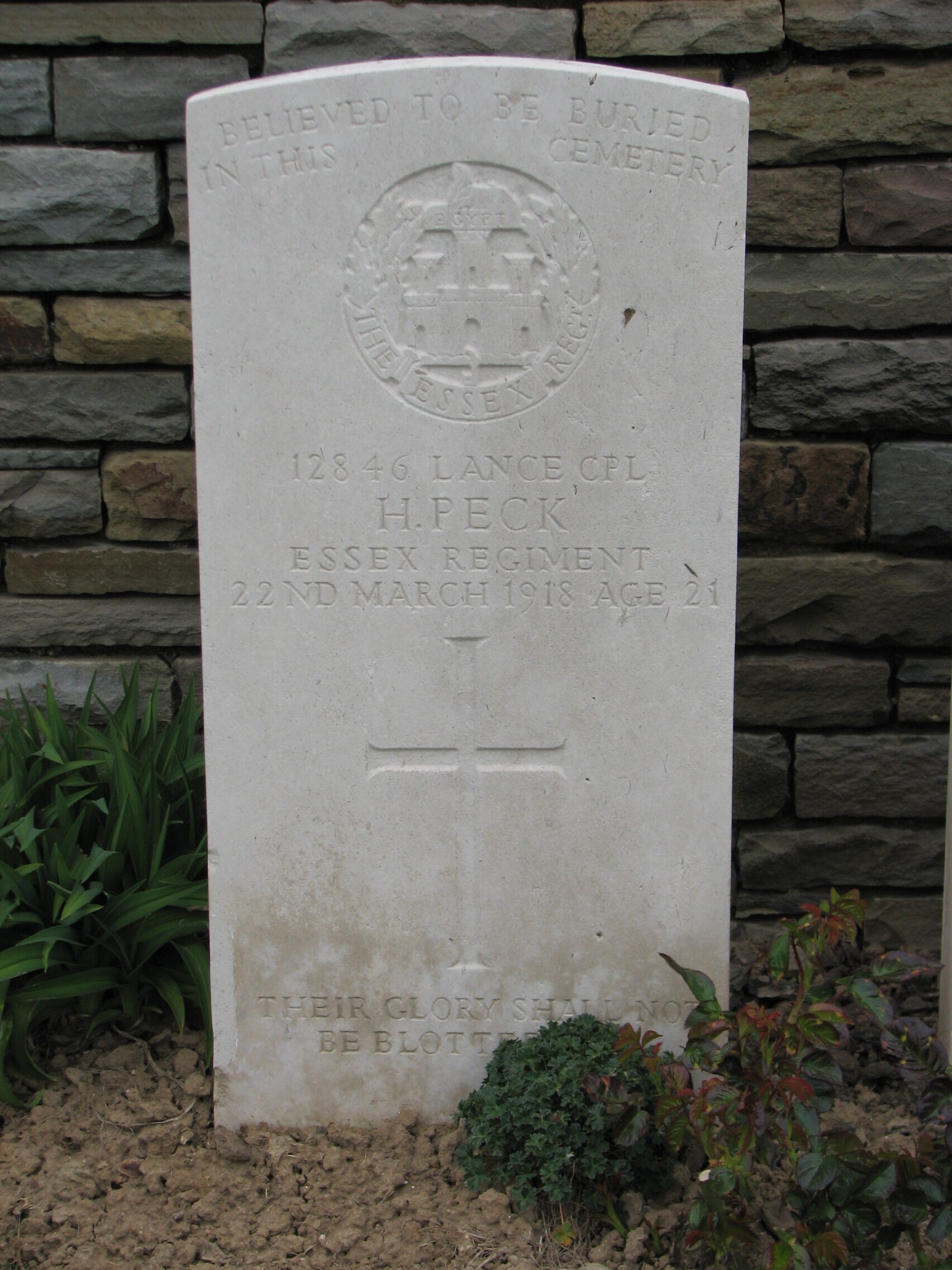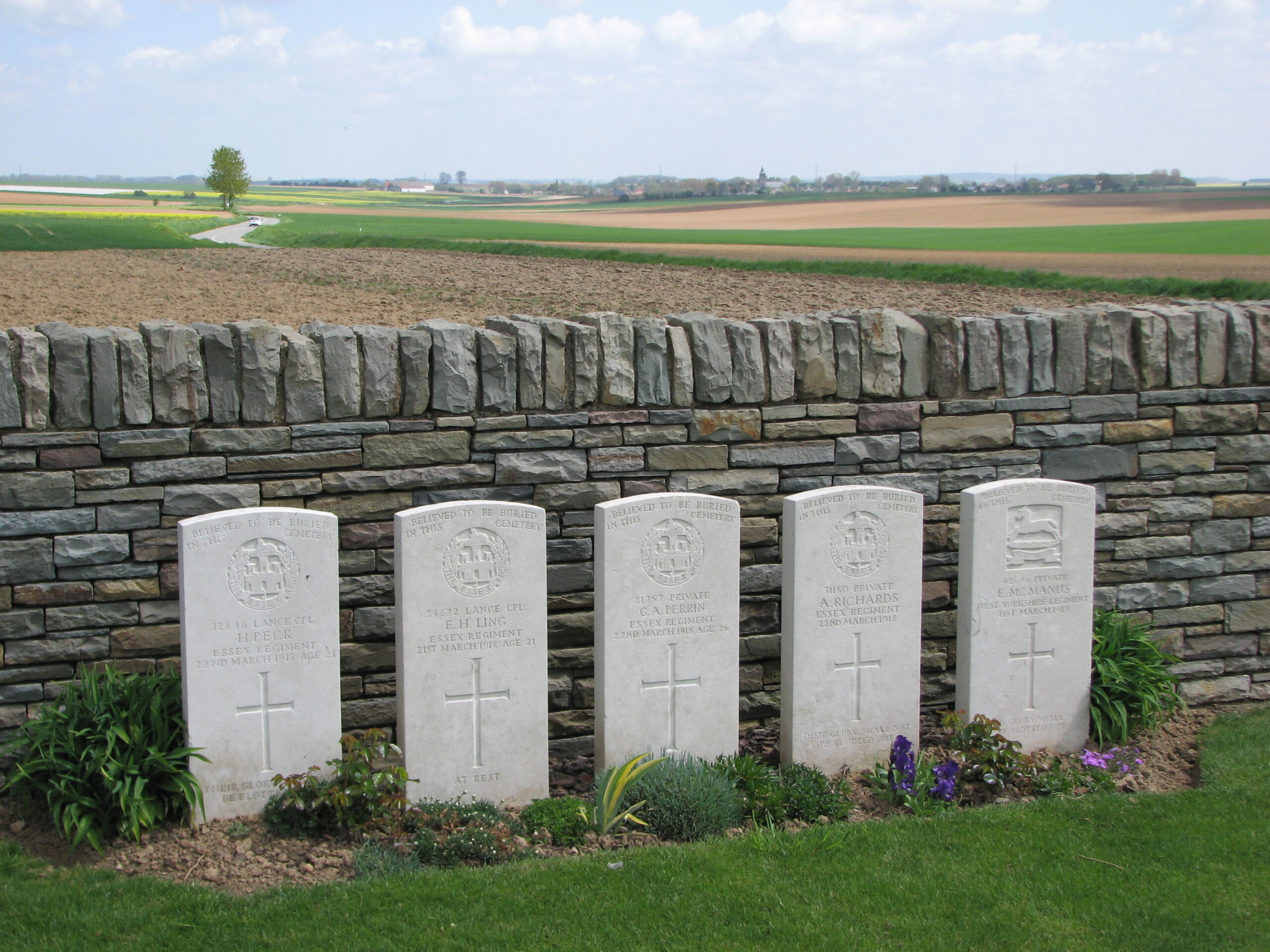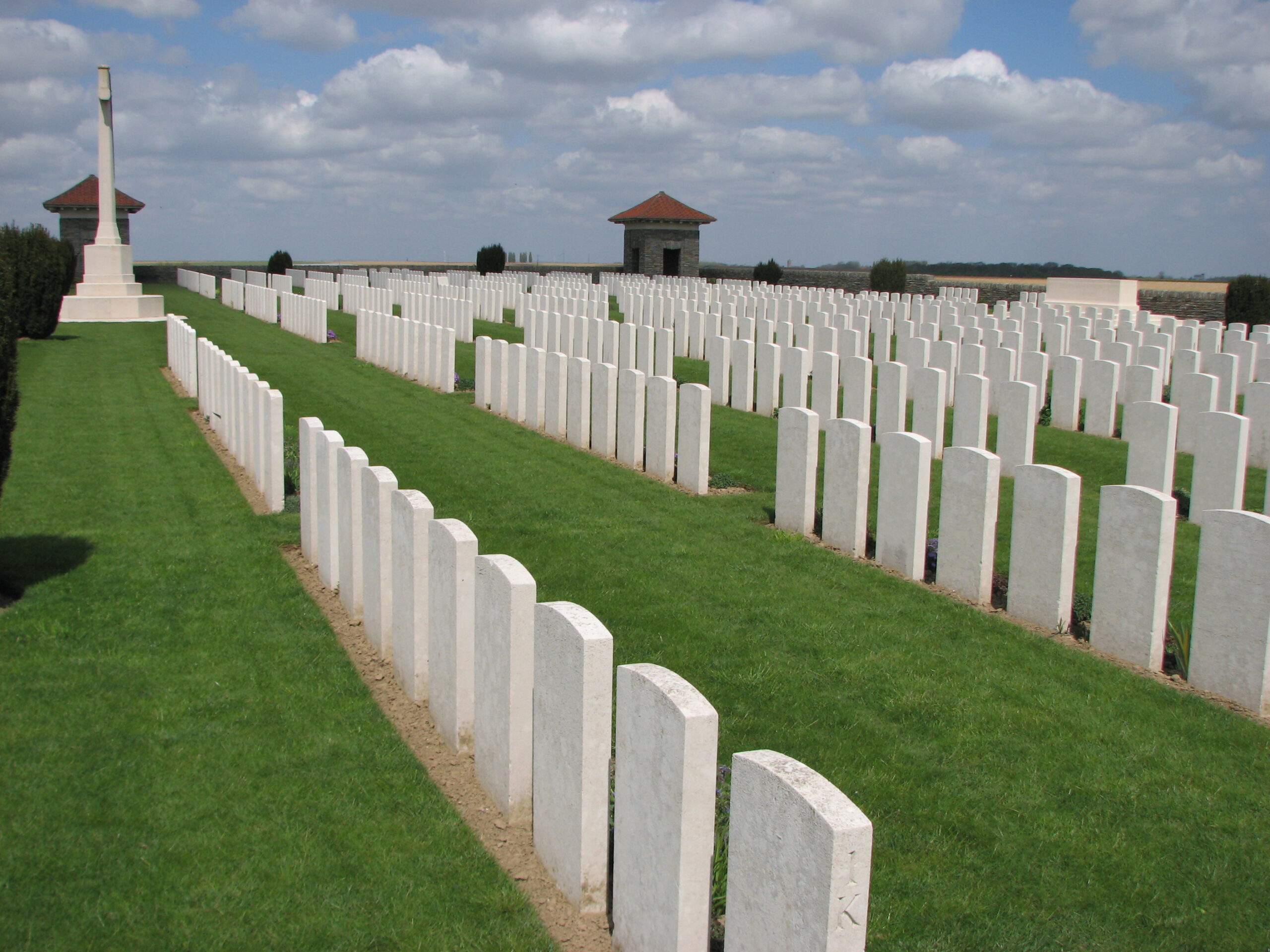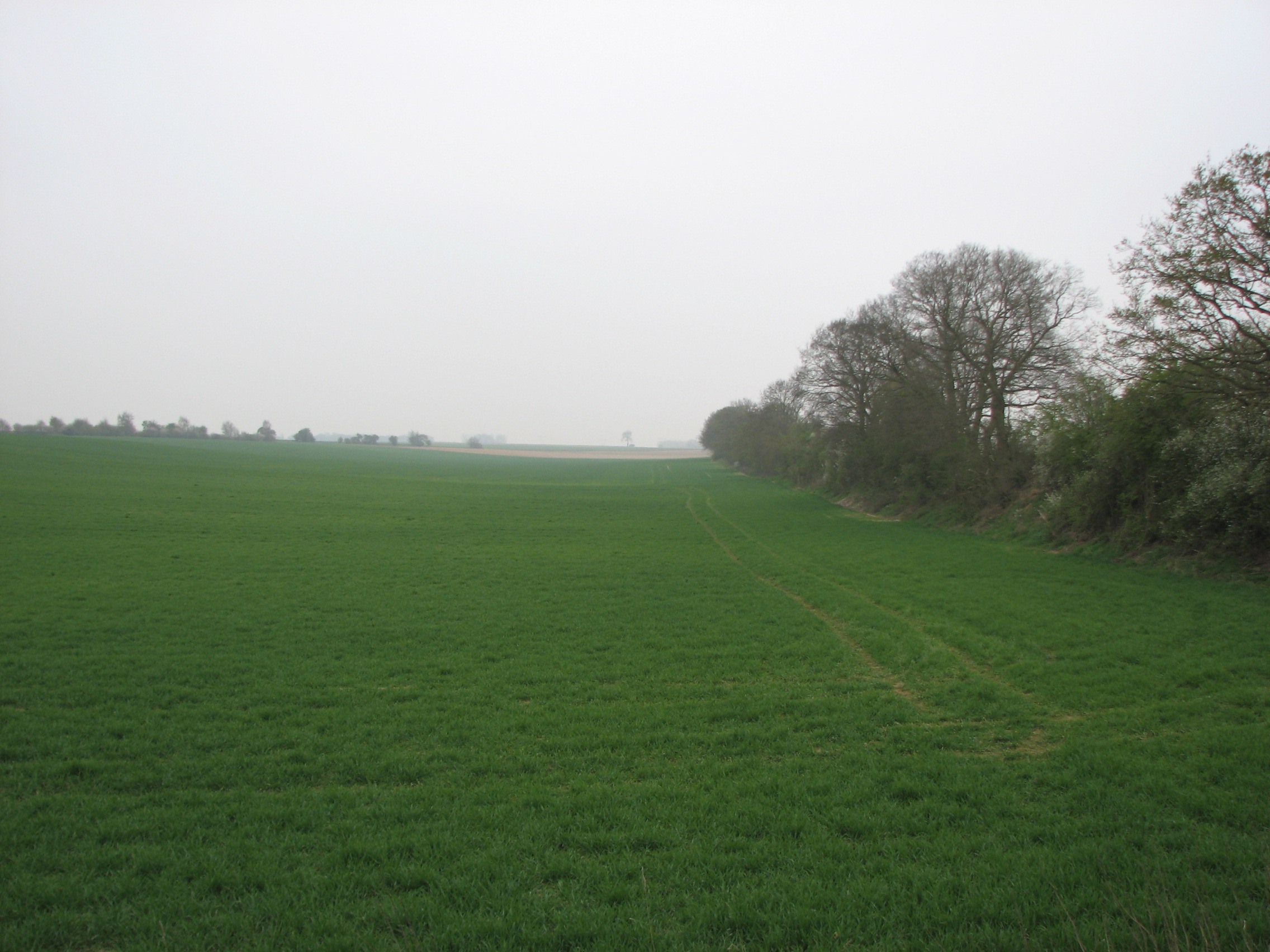Herbert Peck (1896 - 1918)
Herbert volunteered to join the Army in September 1914. He served with the Essex Regiment on the Western Front, before being killed in action on the second day of the great German Spring Offensive in 1918.
- 53
- Died in the Great War
- 51.968369, 1.02847
Details
| Name: | Herbert Peck |
| Service: | British Army |
| Unit: | 11th Battalion, Essex Regiment |
| Regimental Number: | 12846 |
| Rank: | Lance Corporal |
| Date of Death: | 22nd March 1918 |
| Age: | 21 |
| Buried: | Special Memorial B.6, Vaulx Hill Cemetery, Vaulx-Vraucourt, near Bapaume, France |
Family Background and Early Life
Herbert Peck was born in East Bergholt on 20th December 1896, the first child from the marriage of Herbert and Rhoda Peck.
At the time of Herbert’s birth, his father’s occupation was given as a Bricklayer and Labourer, though he was later employed at the British Xylonite Company’s factory at Brantham.
The elder Herbert Peck was originally from Westhall, near Halesworth, who had moved to East Bergholt with his twin brother sometime between April 1881 and April 1891. 1 The elder Herbert’s twin brother, Walter Peck, had 13 children. Five of Walter’s sons served in the Army during the Great War; including Eric and Leonard, who both died:
Eric Peck served with 2nd Battalion of the Suffolk Regiment in France. He was killed on 13 November 1916, during the closing weeks of the Battle of the Somme. Eric is buried in Luke Copse British Cemetery.
Leonard Peck served in the Royal Field Artillery for over three years on the Western Front. He died in 1919 from the effects of a gas attack the previous year and is buried in East Bergholt Cemetery. He married Rhoda Newell, who was from Saxmundham, but who had spent much of her childhood in Kent. Together they would have four children, three boys and a girl. footnote] One of the younger Herbert’s brothers Sidney, served in the Machine Gun Corps during the Great War. Sidney survived the War. He later moved away from East Bergholt and died on the South Coast in 1981.[/footnote]
Herbert started as a pupil at the village school at Burnt Oak on 10th June 1901. At that time the family were living on Rectory Hill. By April 1905, the family had moved to White Horse Road, close to the junction with Hog’s Lane (or Orvis Lane, as it is now called).
Herbert left school on 17th February 1910, and two years later he started work at the Xylonite factory. He was employed in the Slicing “shop”.
Joins the Army
On 7th September 1914, at Colchester, Herbert volunteered to join the Essex Regiment. It appears he may have spent some of his service in England with the Regiment’s 12th Battalion. 2 Until recently, the records of the Commonwealth War Graves Commission (successor to the Imperial War Graves Commission) stated that Herbert’s battalion was the 16th Essex; they now show that his Battalion was 11th Essex but that he was formerly with 16th Essex.
The 16th Essex was only created in early 1917, and never saw service abroad. There is no mention in surviving records of Herbert being with 16th Battalion at any point, so – combined with the fact that it never served overseas – it is quite likely that this reference in the CWGC records is an error of some sort.
The East Bergholt Roll of Honour commemorating all those men from the village who served in the Great War shows Herbert’s battalion as the 13th Essex. The 13th Essex served in the France and Flanders between November 1915 and February 1918, when they were disbanded. It is possible that at some point Herbert did serve with this battalion, or it may also be that this information was incorrectly painted either when the memorial was first made, or when it was restored at the end of the 20th century.
What is clearly documented in the surviving Army records (and backed up by other evidence) is that when he first disembarked in France, Herbert was serving with the 10th Battalion, but at the time of his death he was serving with the 11th Battalion.
The 10th Essex were sent to France, as part of the 18th (Eastern) Division – at the end of July 1915. Herbert himself disembarked in France on 2nd September that year – and was almost certainly part of the reinforcement draft of 115 Other Ranks who joined the 10th Essex on the evening of 8th September.
The Battalion at that time were in the front line to the east of the village of Carnoy on the Somme, which in 1915 and early 1916 was a relatively quiet sector of the front – at least certainly compared to some other areas.
The 10th Battalion would take part in the Battle of the Somme in 1916, and also the Battles of Arras and Third Ypres in 1917. At some point Herbert was transferred from the 10th Battalion, though exactly when we do not know.
11th Battalion, the Essex Regiment
Unfortunately, Herbert’s Service Papers were among those destroyed by bombing during the Blitz, in September 1940. This is of particular relevance when trying to piece together exactly what happened to Herbert, as the surviving records show that he transferred between Battalions at least once after he arrived in France in 1915. Certainly by March of 1918, he was serving with the Essex Regiment’s 11th Battalion. 3 Other East Bergholt men who were serving with the 11th Essex at this time included:
Abram Dale, from Box Corner, who died of wounds on 26th May 1918, at the age of 23. He is buried in Esquelbecq Military Cemetery, France.
Arthur Tatum, from near to the Hare and Hounds, who was wounded and captured in the fighting on 22 March 1918. Released from a Prisoner of War Camp after the Armistice, Arthur died of his wounds on 9th February 1919. He is buried in East Bergholt Cemetery.
Following the end of the Battle of Cambrai in December 1917, the 11th Battalion spent most of the next three months in the area of the Bapaume to Cambrai road. Towards the end of this period – like many units – – their efforts were directed towards fortifying the front line area, and the support positions just behind it.
At this time, the British Expeditionary Force (B.E.F.) – suffering from a manpower crisis and low morale following the heavy fighting and limited successes of the previous year – knew that a German attack was expected. In contrast, the German Army on the Western Front had received a massive influx of manpower, having been able to transfer many divisions from the Eastern Front where the Russians had recently signed an Armistice.
The German Spring Offensive
The 11th Essex were in Brigade Reserve when the full force of the German offensive was unleashed on a 43 mile front, in the early hours of 21st March 1918. Elements of the Battalion were involved in the fighting, trying to stem the German attacks on that first day.
In the sector allocated to the 11th Essex, and the other battalions of the 18th Infantry Brigade, the Germans advanced approximately two miles on that first day. For most of the 22nd March, the Battalion were fighting to the south of the village of Morchies, and successfully held their positions until the evening when they were ordered to withdraw after the Germans broke through to their north.
At some point in the fighting on that day, Herbert was killed. His death was witnessed, and this subsequently allowed the Army to establish quickly that Herbert was definitely dead, and not just wounded and/or a prisoner of war.
Herbert was initially buried with a number of other British soldiers killed in those two days of fighting, just south of the road between Doignies and Lagnicourt-Marcel.
Postscript
After the war, when the bodies from that location were exhumed and reburied in one of the permanent cemeteries being established by the Imperial War Graves Commission, Herbert’s body and those of some of his comrades could not be individually identified. The bodies were reburied approximately three miles away in Vaulx Hill Cemetery, located on the outskirts of the village of Vaulx-Vraucourt.
Because Herbert’s body could not be identified at the time it was reinterred, he is now commemorated in that cemetery by what is called a Special Memorial, rather than a “normal” headstone. The Special Memorial is the standard War Graves Commission headstone upon which are inscribed Herbert’s details, but at the top of the stone have been added the words “Believed to be Buried in this Cemetery”.
Copyright © Mark Ashmore, 2024
- 53
- Died in the Great War
- 51.968369, 1.02847





